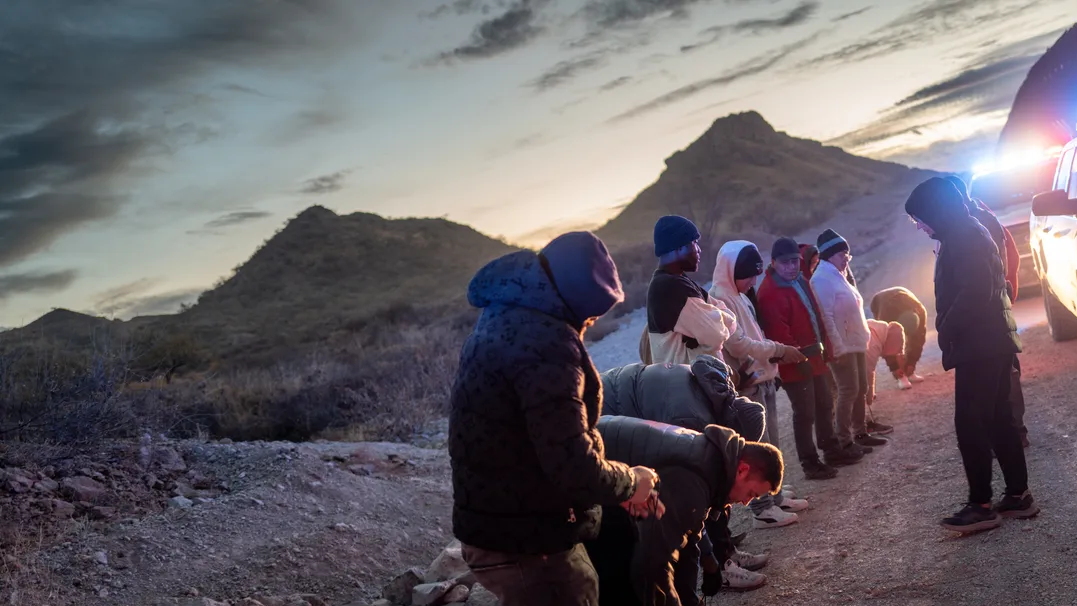 Migrants from Mexico and Guatemala are apprehended by U.S. Customs and Border Patrol officers after crossing a section of border wall into the U.S. on Jan. 04 in Ruby, Ariz. Photo: Brandon Bell/Getty Images
Migrants from Mexico and Guatemala are apprehended by U.S. Customs and Border Patrol officers after crossing a section of border wall into the U.S. on Jan. 04 in Ruby, Ariz. Photo: Brandon Bell/Getty Images
Moments after being sworn in as president for a second time, Donald Trump said he’d declare a national emergency on the U.S.-Mexico border and set plans to sign 10 executive orders that would unleash an aggressive crackdown on illegal immigration.
Why it matters: Some of Trump’s most audacious plans — which include deporting millions of immigrants and ending birthright citizenship — won’t happen immediately and are certain to draw legal challenges.
- But Trump’s emergency declaration — along with designating Mexican cartels as a terrorism threat — would clear the way for using the military to help combat illegal immigration, breaking historical policies for how U.S. forces have been used in the homeland.
Zoom in: Trump aims to further lay the groundwork for what he calls a “common sense” reworking of U.S. immigration policy. In a briefing for reporters before he was sworn in, his team outlined several of the orders. They would:
- Designate cartels and gangs such as MS-13 and Tren de Aragua, as foreign terrorist organizations, and use the Alien Enemies Act of 1798 to use federal and state law enforcement to go after those connected to those groups within the U.S.
- Reinstate the “Remain in Mexico” policy for asylum seekers at the U.S.-Mexico border, ending a policy in which they were released into the U.S. while their cases were being considered by immigration courts.
- Seek to end “birthright citizenship” for those born to undocumented immigrants — a concept promised by the 14th Amendment of the U.S. Constitution.
- Suspend refugee resettlements for four months and expedite removal of those who have sought asylum but don’t the requirements.
- Send troops to the southern border, including the National Guard.
The big picture: The mass deportation Trump seeks will require highly organized raids, a building program for new detention centers, more immigration judges and a steady stream of flights to transport people out of the U.S.
- The large-scale operation will also require a combination of executive authority, congressional action and — almost certainly — Supreme Court backing. Republicans control both chambers of Congress, and the high court has a conservative super majority.
- The plans will also require more funding for carrying out than currently allocated.
- Local and state police will need to assist with raids. GOP-led states have said they will help, while Democratic-controlled states have said they will not.
Reality check: The Wong Kim Ark case of 1898 by the Supreme Court affirmed that any American-born person was a U.S. citizen as defined by the 14th Amendment.
- The case established the Birthright Citizenship clause and led to the dramatic demographic transformation of the U.S.
- U.S.-born children and grandchildren of immigrants from Asia and Latin America are among the nation’s fastest-growing populations. They are expected to be the majority of the country by mid-century.
State of play: An estimated 11 million undocumented immigrants currently live in cities across the country.
- That’s not counting their U.S.-born children (who are U.S. citizens) and millions of other migrants trying to enter the U.S. in the future.
- It’s also not counting the 1.2 million immigrants living in the U.S. who are either receiving or eligible for Temporary Protected Status — a designation Trump limited in his first term and has promised to revoke for Haitians in his second.
The U.S. immigration system’s backlog of 3.7 million court cases will take four years to resolve at the current pace — but that could balloon to 16 years under Trump’s mass deportation plan, according to an Axios analysis late last year.
- Adding 11 million undocumented immigrants would push the backlog review to 2040 at the current pace. That’s without an infusion of new immigration judges or the erasure of due process for many cases.
- U.S. Immigration and Customs Enforcement deported more than 271,000 people last fiscal year — the most in nearly a decade, according to the agency’s annual report released in December.
- At that record pace, it would take around four decades to deport all the 11 million undocumented immigrants in the U.S. today.
Zoom in: The new Trump administration seeks to upend the whole deportation process and could sign legislation from a GOP-controlled Congress that may allow him to bypass current laws.
- Stephen Miller, the White House’s deputy chief of staff for policy, met with members of Congress in January to share ideas on how to overcome a filibuster in the U.S. Senate on enforcement laws and force Democrats to vote on bipartisan measures.
- During a meeting with senators, Miller walked through the Day 1 immigration executive orders. That included the reinstatement of pandemic-era Title 42, which allows rapid expulsion of migrants at the border.
Between the lines: An Axios-Ipsos poll released Sunday found that 66% of Americans support deporting immigrants who are in the country illegally.
- That same poll found that support nearly dropped in half when asked about tactics for deportation like active duty military to find and detain undocumented immigrants or separating families.
What we’re watching: The American Civil Liberties Union (ACLU) is vowing to challenge any Trump executive order on immigration the group feels violates the Constitution and human rights.
- Those court challenges would slow down any deportation operation.
- The ACLU brought more than 400 cases against the first Trump administration as it fought to stop Trump’s Muslim travel ban and fight allegations of abuse at immigration detention centers.


